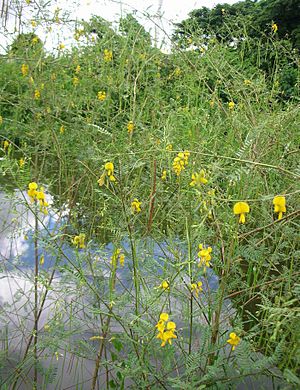Sesbania bispinosa facts for kids
Quick facts for kids Sesbania bispinosa |
|
|---|---|
 |
|
| Scientific classification | |
| Synonyms | |
|
Sesbania aculeata (Willd.) Pers. 1807 |
The plant called Sesbania bispinosa is a type of legume, which is a family of plants that includes peas and beans. It's also known as Sesbania aculeata. This small tree belongs to the Sesbania group. Its flower is special because it's the official flower of Phra Nakhon Si Ayutthaya Province in Thailand.
Contents
Discovering Its Names
The name Sesbania comes from its Arabic name, "Siesaban". This plant has many common names around the world. Some of these names include danchi, dunchi, dhaincha, canicha, prickly sesban, jantar, or spiny sesbania. In Vietnam, people call it điên điển gai or điền thanh gai. In Cambodia, it is known as ស្នោ (Pka Snaô).
Where Does This Plant Grow?
This plant originally comes from Asia and North Africa. It is very common in tropical parts of Africa, where it sometimes grows like a common weed. It has also been brought to the Americas. A cool fact about Sesbania bispinosa is that it can even grow in salty soil!
Preferred Growing Conditions
Sesbania bispinosa likes wet, heavy soil. However, it can also grow well in places that don't get much rain or in sandy areas. It is grown a lot in India. In Vietnam, farmers plant it in rice paddies to use its wood for burning.
What Does Sesbania Bispinosa Look Like?
This plant is an annual shrub, which means it lives for about one year. It can grow up to seven meters (about 23 feet) tall, but it usually stays between one and two meters (3 to 6.5 feet) tall. It has strong, soft stems and long leaves. The plant produces yellow flowers with purple spots. After the flowers, it grows pods that hold light brown beans inside.
How Is This Plant Used?
Sesbania bispinosa is a very useful plant! People use it for many different things:
- Fibers: Its fibers are similar to those from birch trees. They can be used to make ropes, fishing nets, and even strong cloth for sacks or sails, much like industrial hemp. Scientists are also looking into using its fibers to make paper.
- Food and Fodder: The leaves are good food for farm animals like cows. The beans can be fed to chickens and other fowl. In times when food is scarce, people have even eaten parts of this plant.
- Natural Thickener: A natural gum from the plant can be used to make liquids thicker.
- Soil Improvement: Like other legumes, this plant helps the soil. It can add important nutrients to the ground through a process called nitrogen fixation. This makes the soil healthier for other plants.
- Firewood: The wood from Sesbania bispinosa burns well, making it a good source of firewood.
Culinary Uses: Eating the Flowers
The yellow flowers of Sesbania bispinosa are eaten as a vegetable in Southeast Asia. They are smaller than the more common white flowers of Sesbania grandiflora, but they have a similar shape. People enjoy these flowers in Thai and Vietnamese cuisine.
In the Thai language, these flowers are called ดอกโสน (dok sanō). In Thai cooking, the flowers are used both cooked and raw. They can also be added to omelets or used to make sweet dishes.
Images for kids
See also
 In Spanish: Sesbania bispinosa para niños
In Spanish: Sesbania bispinosa para niños



